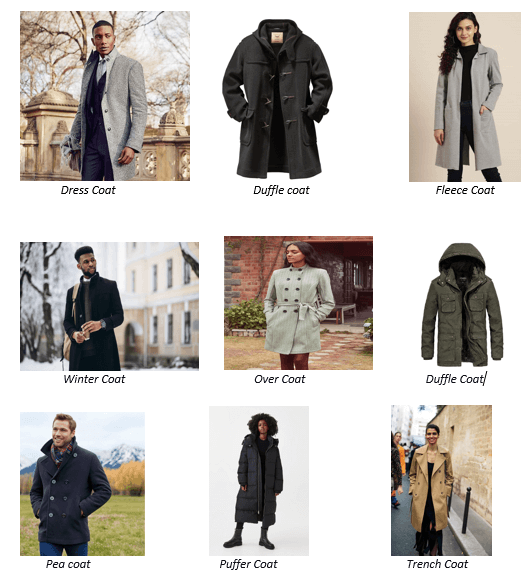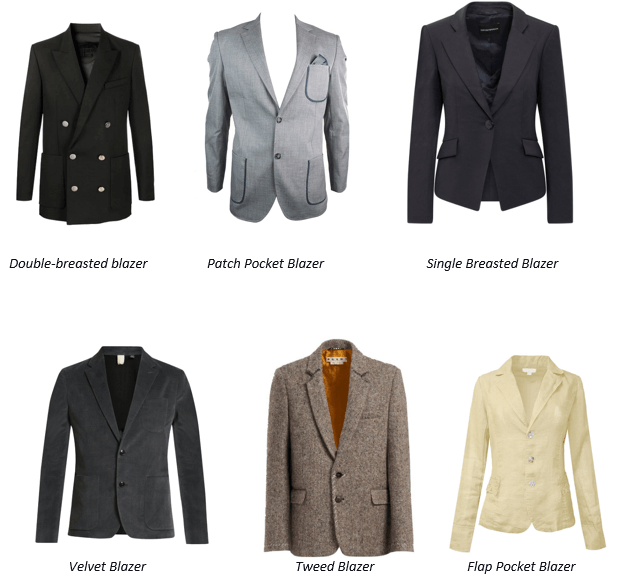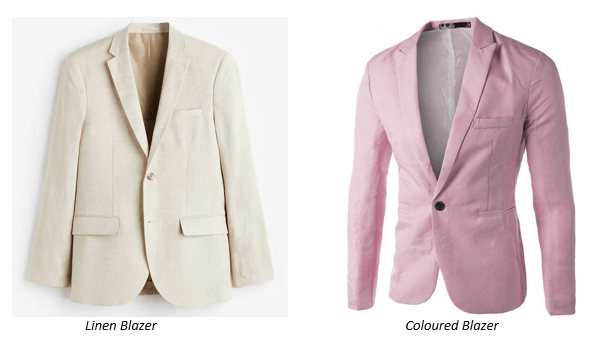Difference Between Coat and BlazerIntroductionA Coat and a Blazer are two different types of outerwear, with key differences in style, fabric, and intended use. A Coat is typically a heavier, longer outer garment worn to provide warmth and protection from the elements. Coats can be made from various materials, including wool, cashmere, down, or synthetic fibers, and can have multiple features, such as hoods, zippers, and pockets. Coats come in different styles, such as trench coats, pea coats, and parkas, and are often worn over other clothing, such as suits, dresses, or casual outfits. On the other hand, a blazer is a lighter, more formal jacket often made of wool, cotton, or a blend of materials. Blazers are typically tailored and have a more structured and refined appearance than coats. They usually feature a single-breasted design, notch lapels, and two or three buttons. Blazers are commonly worn as part of a business or dressy casual outfit, often with dress pants or skirts, dress shirts, and ties. The main differences between a coat and a blazer are their weight, intended use, and formality. Coats are heavier and designed for warmth and protection, while blazers are lighter, more formal, and often worn for business or dressy casual occasions. What is a Coat?A Coat is an outer garment typically worn to provide warmth and protection from the elements. It is often made of heavier materials such as wool, cashmere, or down and can come in various styles and designs to suit different purposes and occasions. One of the most popular coat types is the trench coat, originally designed for British soldiers during World War I. It is a long coat that typically falls below the knee, with a double-breasted front, a belt at the waist, and a detachable lining. Trench coats are often made of waterproof materials such as cotton gabardine or polyester and are designed to keep the wearer dry and warm in wet and windy weather. Another common coat type is the pea coat, a shorter, double-breasted coat that sailors originally wore. Pea coats are typically made of wool and often have a thick, quilted lining for added warmth. They usually have a classic, timeless look that can be dressed up or down depending on the occasion. Parkas are another type of coat that is popular in colder climates. They are typically longer than other coats, falling below the knee, and are often made of synthetic nylon or polyester. Parkas usually have a hood designed to provide maximum warmth and protection from the elements. Other types of coats include duffle coats, which are made of heavy wool and have toggle fastenings, and puffer jackets, made of lightweight materials such as nylon and filled with down or synthetic insulation. There are also dress coats, typically worn for formal occasions and often made of wool or cashmere, and overcoats, typically longer and worn over a suit or other formal attire. In addition to their functionality and warmth, coats can be fashionable and used to make a statement or add a unique touch to an outfit. They come in various colors, patterns, and materials and can be dressed up or down depending on the occasion. A good coat can be a versatile and long-lasting addition to any wardrobe, providing practicality and style. History of CoatThe history of coats can be traced back to ancient times when people used animal hides to protect themselves from cold weather. Over time, coats have become an essential part of fashion and a symbol of social status. Let's explore the history of coats in more detail.
In ancient times, people used animal hides and furs as coats to protect themselves from harsh weather conditions. These coats were often made from bear, wolf, and fox skins. The hides were treated with oils and fats to make them waterproof and were often decorated with beads and shells.
During the Middle Ages, coats became a symbol of social status. The wealthy wore long, flowing coats made from luxurious materials such as silk and velvet, while the poor wore simple, practical coats made from wool or linen.
In the Renaissance era, coats became more fitted and tailored. Men's coats were often adorned with buttons and embroidered designs, while women's coats were long and made from rich fabrics such as brocade and damask. 18th Century: During the 18th Century, coats became more ornate and decorative. Men's coats were often embroidered with gold and silver thread, and women's coats featured intricate lace and frills.
In the 19th Century, coats became more practical and functional. The Industrial Revolution brought about new materials, such as wool and cotton, which made coats more affordable and accessible to the masses. Women's coats became shorter and more practical, while men's coats became simpler and more streamlined.
In the 20th Century, coats became an integral part of fashion. Designers like Coco Chanel and Christian Dior revolutionized coat design, introducing styles like trench and pea coats. Coats also became a symbol of rebellion, with leather and denim jackets becoming popular among the youth. Today, coats come in various styles, from classic wool overcoats to trendy bomber jackets. They are worn for practical reasons, to protect against the cold, and as a fashion statement. Coats continue to evolve and adapt to changing fashion trends and technological advances in materials and manufacturing. Types of CoatMany different types of coats are available, each with unique features and intended use. The coat you choose will depend on your style, climate, and the occasions you plan to wear it. A good coat can be a versatile and long-lasting addition to any wardrobe, providing practicality and style. Below are some of the most common types of coats and their features 
Trench CoatA Classic Trench Coat is a long coat that falls below the knee and is typically made of waterproof materials like cotton gabardine. It often features a double-breasted front, epaulets, a belt at the waist, and a detachable lining. Trench coats are often worn as an overcoat for formal and casual occasions. It is a classic coat that was originally designed for military use. It is made from a water-resistant material and features a double-breasted front, a belt, and a wide collar. Trench coats are a versatile addition to any wardrobe and can be dressed up or down depending on the occasion, and they are often worn as lightweight, rainproof coats in spring and fall. Pea CoatA Pea Coat is a shorter, double-breasted coat that sailors originally wore. It is often made of wool and has a quilted lining for warmth. Pea Coats have a classic, timeless look that can be dressed up or down depending on the occasion. It is a classic, double-breasted coat made from a heavy woolen material. It features a wide lapel and large buttons and is often worn as a casual winter coat. Pea coats originated in the naval forces and were designed to provide warmth and protection from the wind and cold. ParkaA Parka is a long coat that is typically worn in colder climates. It is often made of synthetic materials like nylon or polyester and has a hood for protection. Parkas are designed to provide maximum warmth and protection from the elements and often feature large pockets and a drawstring waist. Duffle CoatA Duffle Coat is a heavy wool coat typically featuring toggle fastenings, a hood, and patch pockets. It has a casual, rustic look and is often worn for outdoor activities or casual occasions. The duffle coat is a classic winter coat that originated in the British Royal Navy. It is made from a heavy woolen material and features a toggle closure in the front. Duffle coats have a hood, often lined with fur, and large pockets for storage. They are popular for those living in colder climates and are usually worn for outdoor activities such as hiking and camping. Puffer Jacket/coatA Puffer Jacket is a lightweight coat with down or synthetic insulation to provide warmth. It is often made of nylon or polyester and has a quilted design that helps to trap heat. Puffer Jackets are popular for their warmth and lightweight. Some uses of puffer coats are given below.
OvercoatAn overcoat is a long coat typically worn over a suit or formal attire. It is often made of wool or cashmere and has a classic, timeless look. Overcoats come in various styles, from single-breasted to double-breasted, and are often designed to provide warmth and protection in cold weather. Some common ways to use an overcoat:
Dress CoatA Dress Coat is a formal coat often worn for black tie events or other formal occasions. It is typically made of wool or cashmere and has a sleek, tailored design. A dress coat, or formal coat, is a long overcoat typically worn with formal attire. It is made from a high-quality wool blend and features a tailored fit. Dress coats often have a single-breasted front with two or three buttons, and they may have a velvet collar. They are a classic and timeless addition to any wardrobe and are often worn to formal events such as weddings and black-tie occasions. Fleece JacketA Fleece Jacket is a lightweight coat often worn for outdoor activities or casual occasions. It is made of synthetic materials like polyester and has a soft, fuzzy texture, and Fleece jackets are popular for their warmth and comfort. Fleece coats are made from a soft, synthetic material that provides warmth and comfort. They are often lightweight and can be worn as a mid-layer or outer layer, depending on the weather. Fleece coats come in various styles and colors and are often used for outdoor activities such as hiking and skiing. Winter CoatWinter coats are designed to provide warmth and protection from the elements during the colder months. They come in various styles, from long woolen overcoats to puffer jackets. Winter coats are often made from high-quality materials such as down and Gore-Tex, which provide insulation and water resistance. What is a Blazer?A Blazer is a jacket similar in style to a suit jacket but more casual in its cut. They are often made from solid color fabrics and have a more formal appearance than a sport coat. Blazers are typically worn by both men and women and are known for their nautical-style metal buttons, which reflect their origin as jackets worn by members of boating clubs. The cloth used to make blazers is usually durable, as they are intended for outdoor wear. They are often worn as part of a uniform designating the wearer's affiliation with a particular organization or team. For example, airline employees, school pupils, and sports club members may wear blazers as part of their uniforms. Blazers can be paired with a wide range of clothing, from dress shirts and neckties to polo shirts or plain T-shirts. They can also be worn with various trousers, from classic white cotton or linen to grey flannel, brown or beige chinos, and even jeans. One popular blazer design is the double-breasted navy blue blazer with nautical-style buttons, sometimes called a "reefer" blazer. This classic, fitted design is particularly popular in North America and the United Kingdom and is often worn as part of business casual attire. Blazers are also commonly worn as part of school uniforms in many Commonwealth countries, including the UK, Australia, New Zealand, and South Africa. These traditional blazers are typically single-breasted and brightly colored, often with piping. They may also have a badge on the breast pocket to signify the wearer's affiliation with a particular school or organization. In military organizations, blazers are often worn as part of the dress uniform and may have a badge or wire badge sewn onto the breast pocket. Regimental associations may also have their own "regimental blazers" unique to their organization and may be sourced from different suppliers. The standard color for regimental blazers is navy blue, although some organizations may use different colors to distinguish themselves. History of BlazersBlazers began in the mid-19th Century as a sporting jacket for rowing teams at the prestigious British school Cambridge University. The rowing team wanted a durable, practical jacket but also stylish and distinctive, so they came up with the blazer. At first, blazers were only worn for sporting events, but they soon became fashionable for both men and women. The classic blazer featured a navy blue wool fabric with brass buttons and a slim, tailored fit. Over time, blazers came in various colors and patterns, including bold stripes, plaids, and checks. Blazers were particularly popular in the 1950s and 1960s, worn as part of the preppy Ivy League looks. In the 1980s, blazers took on a more oversized and boxy shape, often worn with shoulder pads for a power-dressing effect. Blazers remain a versatile and stylish wardrobe staple, worn for formal and casual occasions. They can be dressed up with dress pants or a skirt for work, a special event, jeans, and a t-shirt for a casual look. Types of Blazer

Next TopicDifference between
|
 For Videos Join Our Youtube Channel: Join Now
For Videos Join Our Youtube Channel: Join Now
Feedback
- Send your Feedback to [email protected]
Help Others, Please Share










